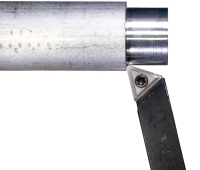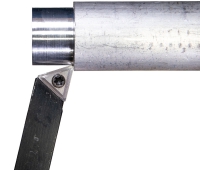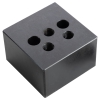Turning Tool Nomenclature
Understanding naming conventions for turning tools is interesting, but know that there are no rules about when to use
each tool. Take a look at the job at hand and pick a tool that will do the
job—no matter what it's called.
Right Hand Turning Tool
 |
A right-hand cutting tool removes metal when moving from right to left.
This is the most common turning activity, cutting towards the lathe chuck.
The cutting edge is on the left side. Tools where the second letter
is "R" are right-hand tools.
Always cut with the point of the insert. The tool shown is at the
proper angle for turning to a 90-degree shoulder. Move
right to left to turn the diameter, then move the tool out to
face the 90-degree shoulder.
|
Left Hand Turning Tool
|
A left-hand cutting tool removes material when moving from left to right.
This tool cuts away from the lathe chuck. The cutting edge is on the right
side. Tools where the second letter is "L" are left-hand tools.
Always cut with the point of the insert. The tool shown is at the
proper angle for turning to a 90-degree shoulder. Move
left to right to turn the diameter, then move the tool out to
face the 90-degree shoulder.
|

|
AR Tool Bit

 |
The AR-style tool has a 0-degree side cutting angle for general machining
applications such as turning, facing, and chamfering. It's suitable for machining
to a 90-degree shoulder. The cutting edge is on the left for right-to-left feed.
|
AL Tool Bit

 |
The AL-style tool has a 0-degree side cutting angle for general
machining applications such as turning, facing, and chamfering.
It's suitable for machining to a 90-degree shoulder. The cutting edge is
on the right for left-to-right feed.
|
BR Tool Bit
 |
The BR tool bit has a 15-degree side cutting angle for roughing or heavy
machining when turning and facing. The BR-style tool shape has a lead angle
that distributes the cutting load for interrupted or irregular cuts and
gradual entrance to the workpiece. The cutting edge is on the left for
right-to-left feed. The off side is at a 45-degree angle, which is handy for chamfering.
|
BL Tool Bit
 |
The BL tool bit has a 15-degree side cutting angle for roughing or heavy
machining when turning and facing. The BL-style tool shape has a lead angle
that distributes the cutting load for interrupted or irregular cuts and
gradual entrance to the workpiece. The cutting edge is on the right for
left-to-right feed. The off side is at a 45-degree angle, which is handy for chamfering.
|
E Tool Bit
 |
The E tool bit has a neutral cutting direction and a sharp tip with a
60-degree angle for threading. It can also be used for chamfering,
notching, V-grooving, and undercutting.
|
|










 Plinth Block, Mini Lathe
Plinth Block, Mini Lathe Cut-Off Blade, P1
Cut-Off Blade, P1
